| Home | First Posted: Aug 13, 2010 Jan 21, 2020 | |
Malta, Sicily and Romeby Debora JohnsonDoors of Malta, Sicily and Rome/Galleries Bill and I got the wonder lust, again, so Bill planned an entire trip. He did a wonderful job of it with attention to every detail. The following may be helpful to some of you who are planning a similar trip. To others, it just might be enjoyable reading. I have divided this article into three parts--Malta, Sicily, and Rome. There are also galleries which I thought you might enjoy. While travelling I decided to do a gallery of "doors" from the three countries. The doors were particularly beautiful. The old dilapidated doors I found to be intriguing. The antiquity just inspired me. I might do a series of paintings on doors. There is already one under paintings of Cat and Antique Door/Italy. My Oil Paintings MaltaI just want to mention that there are many carriage horses in Malta. I asked one of the carriage drivers, "What is the breed of the horse?" His answer was that he did not know the breed but most of the horses come from Tunesia. Bill and noticed that the horses were gaited horses like our Tennessee Walkers or Kentucky Mountain horses. They had beautiful conformations and moved with grace and smoothness. They also came in all colors. Legendary Horses: Small but tireless, lively but docile, ungainly but fast, the Barb horse is a highly appreciated breed from time immemorial. Carthaginians, Romans and Byzantines valued this horse native to the Berber country, perfectly adapted to the arid regions. Splendid mosaics in the Tunisian museums bear witness to that fact. They may well be the Tunisian horses that the first Moslems who set foot on the African soil adopted and which led them as far as Spain. Arabian, Barb and Arabo-Barb horses are bred in Tunisia today. Tunisian Horses  Flag of Malta
"...The Republic of Malta (Maltese: Repubblika ta' Malta), is a densely populated developed European country in the European Union. The island nation comprises an archipelago of seven islands situated in the Southern European areas of the Mediterranean sea, 93 km off the coast of Sicily (Italy), 288 km east of Tunisia and 300 km north of Libya. The islands enjoy a Mediterranean climate. Throughout its history, Malta's location in the Mediterranean Sea has given it a strategic importance. Consequently, a sequence of powers including the Phoenicians, Romans, Fatimids, Sicilians, Knights of St John, French and British have all conquered Malta. Malta gained independence from the United Kingdom in 1964 and became a Republic in 1974 but remains a member of the Commonwealth of Nations. It is currently a member of the European Union, which it joined in 2004, and also of the United Nations. Malta is known for its world heritage sites, most prominently the Megalithic Temples which are the oldest free-standing structures on Earth. According to the Acts of the Apostles, St. Paul was shipwrecked on the island. Malta is also considered a potential location for the mythical lost island of Atlantis. Malta's capital city is Valletta. The country's official languages are Maltese and English, which replaced Italian in 1934. Malta has a long legacy of Roman Catholicism, which continues to be the official and dominant religion in Malta..." SicilyFollow this link and click on recipes. Hanging, bobbing books will appear. Click on them. They contain the recipes that are wonderfully tasty!
"Sicily (Italian and Sicilian: Sicilia) is an autonomous region of Italy. Of all the regions of Italy, Sicily covers the largest land area at 25,708 km square and currently has just over five million inhabitants. It is also the largest island in the Mediterranean Sea. In addition, several much smaller islands surrounding it are also considered to be part of Sicily. Along with Sardinia, the island is officially classified as a region of Insular Italy. Throughout much of its history, Sicily has been considered a crucial strategic location due in large part to its importance for Mediterranean trade routes. The area was highly regarded as part of Magna Graecia, with Cicero describing Siracusa as the greatest and most beautiful city of all Ancient Greece. Although today Sicily is a region of Italy, the island was once a city-state in its own right, and as the Kingdom of Sicily ruled from Palermo over southern Italy, Sicily, and Malta. It later became a part of the Two Sicilies under the Bourbons, a kingdom governed from Naples that comprised both the island itself and most of Southern Italy. The Italian unification of 1860 led to the dissolution of this kingdom, and Sicily became an autonomous part of the Kingdom of Italy. Sicily has its own unique culture, especially with regard to the arts, cuisine, architecture and language. The Sicilian economy is largely based on agriculture (mainly orange and lemon orchards); this same rural countryside has attracted significant tourism in the modern age as its natural beauty is highly regarded. Sicily also holds importance for archaeological and ancient sites such as the Necropolis of Pantalica and the Valley of the Temples..." Our Sicily Trek  Bill and I took Virtu Ferry LTD from Malta to Pozzallo. A one way economy ticket cost 87 euros each. This site: Tourism and Travel in Malta will get you to Virtu Ferries. We picked up our rental car at Harbour - Porto turistico Pozzallo, Italy, from Hertz. It is the only rental car place at this particular ferry landing. Bill saved us a rental car through the internet by using the Hertz Rental Car site. You have to enter your destination, etc. The name of the Hertz dealer was Siciltour of Ricca Pietro & C. s.a.s., www.siciltour.org - info@siciltour.org (Viaggi Nazionali ed Internazionali). Vehicles are limited. Make sure to go over every inch of your vehicle for dings, dents, etc. Be sure to have an international driver's license which you obtain in the US before you depart. Also, you must have your valid US license, as well. Get insurance, as there does not seem to be any sanity to driving in Sicily and Italy. If we had not purchased an international UPS device before we left, we would have been in BIG trouble! You turn down alley ways that are so small that you have to turn in both mirrors or they would be torn off. No one stops for pedestrians. Close your eyes and just cross the street. I would say that to a non Italian there seemed to be complete chaos on the roads, however, as in India, the locals "get it" we don't! Do not falter! The roads are hardly wide enough for one car so turning around and passing are out of the question for non natives. You are OK when driving on the autostradas. The speed is fast, but the roads are adequate. Learn the road signs before you leave. Hertz did not have any information on road signs, nor did they have any useful maps. Horrors if we did not have the international UPS device! Do not leave anything in the car that is visible. Smash and grab is alive and well. I suggest that you get an car with a trunk not a hatch. Also, get as small a car as possible. Gas is very expensive. It is approximately 4 liters to the gallon so you will pay around $6.00 a gallon. (That is a ballpark figure and is subject to change, of course) Petrol stations are often well hidden. We had a lovely drive to Siracusa, Italy. Our accommodation was located on the island of Ortigia in the heart of the historic center of Siracusa. This charming hotel is set in a 14th-century property. You can walk everywhere. It is quaint and lovely with lots of fine dining and tons to see. Our accommodation was fabulous. It is called Domus Mariae and is run by nuns. The three days we were there a new spa and wellness center was opened. Take in the beautiful sea view on the terrace at Domus Mariae. It has a grand, multifunctional hall where you can read, watch TV, and even hold conferences. A highlight is definitely the spacious terrace, which invites you to admire the sunset while enjoying a drink from the bar. Domus Mariae Benessere features a modern spa with a range of massages and beauty treatments available. You can work out at the gym or relax in the Jacuzzi or steam bath. Your guest room is air conditioned and comes with Satellite TV; some also have a hydromassage bathtub. Sample the best of Mediterranean and Sicilian cuisine at the restaurant, which can also provide personalized menus, recommended by wellness professionals. Make sure to tell them to hold the salt! This new health center is across the street from where we stayed. I must say that we preferred staying in the annex. It was quieter and much more personal. Cinzia (Cynthia in English) made our stay. She was an enormous help with restaurants, buses, sights, etc. When we arrived there was a parking space out front. She gave us a note to put in the windshield and suggested we leave the car parked there for the duration of our stay and see the sights by walking and public transport ion. We did just that. She had our baggage taken upstairs. She opened the door to our room and told us we had the "miracle room." And that it was! With great flare and a big smile she flung open the heavy floor to ceiling wooden shutters. A cool salt sea breeze filled our lungs and brushed our faces while a beautiful balcony awaited. The view was magnificent. The room was on the 4th floor. Just ask for the miracle room--there is no other room like it! Here is a picture of sweet Cinzia and below that picture my Bill on the balcony.  Sweet Cinzia
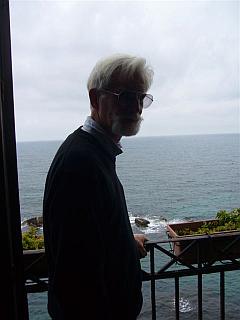 Domus Mariae - Bill looking out the balcony window in the"Miracle Room"
Now that the Health Spa has opened it may be difficult to even get a room. I would suggest you book well in advance. I would also like to add that while we were in Ortigia the G-8 meetings were being held. Part of the island was closed off unless you were part of the G-8. There were more "policia" in this small area than all of Rome! We counted 4 different types of police not including under cover police. Security was high. There were many demonstrations. We saw many environmentalist organizations and financial organizations, etc. Below are a few pictures that we took of some of the environmentalist propaganda. This meeting really enhanced our stay. On the last day the G-8 left and we got to see the closed off part of Ortigia.  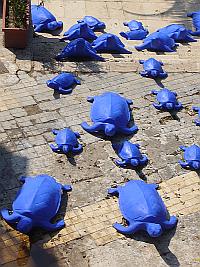 Photos ©HorseHints
Trash Statues and Turtles - Environmental Statement
Ortigia and Siracusa"The island of Ortigia is the historical heart of the town. There are fewer archaeological sites exposed to view here (the island has been heavily built-up ever since the time of the Greeks), but this is the part of Siracusa you're likely to be wandering around after you've 'done' the mainland points of interest. The island is a pleasant place to wander, and much of its charm lies in wandering down the narrow medieval lanes, past romantically-crumbling Baroque and medieval palaces and churches. A walk around the perimeter of the island is a good way to begin to get your bearings. With a map and a guidebook you can locate individual buildings of note, such as Palazzo Montalto (under restoration), but it's just as much fun exploring for yourself and discovering your own favorite places: abandoned palazzi where weeds and bushes swarm over the dilapidated balconies, corners where you catch glimpses of sky through once-grand windows, carefully-tended cactus plants, sea front churches, picturesque alleys and so on. One of the most wonderful finds was the elegant, 17th-century Palazzo Arcivescovile now home to the Biblioteca Alagoniana and some rare 13th-century manuscripts. It is a must see and is not on the regular tourist path. The treasures that are hidden behind a facade were a real find! The island is joined to the mainland by three bridges (one of which is a recent and controversial addition). The central bridge, Ponte Umbertino, continues the line of the wide Corso Umberto, one of Siracusa's major thoroughfares. As you cross on the island, turning left will take you towards the headquarters of the two bus companies serving the area. Opposite the bridge are the majestic ruins of the Greek Temple of Apollo. Veering right up Corso Matteotti you'll pass a range of clothes and shoe shops, before arriving in Piazza Archimede, at the centre of Ortigia. Rather blighted by the stream of cars cruising around its central fountain, the piazza is nevertheless a fairly attractive focal point, and a good place to start your explorations of the island. To head straight to Ortigia's most attractive piazza, turn right and head for Via Cavour (which continues as Via Landolina), a narrow thoroughfare lined with restaurants and souvenir shops. A minute's walk to the left lies Piazza Duomo, an elliptical open space lined with harmonious and impressive buildings - and also a good place to sit and enjoy refreshments at an outdoors cafe table. For trendy bars and a pleasant stroll during the traditional evening passeggiata, head towards the thirteenth-century Castello Maniace. The fortress at the island's tip is still a military establishment and closed to the public, but the sea front from here back up the western shore of the island, past the Fonte Aretusa, is lined with cafes, bars and restaurants, and thronged with locals out for their sociable promenade. Duomo Siracusa's Duomo is one of the town's most celebrated sights. The building records the many ages of the town. Once it was the Greek Temple of Athena, and the massive Doric columns of the temple are still visible; rather wonky after earthquake damage. The wall above the columns along Via Minerva, with battlements, is Norman in origin, while the fancy Baroque facade was a replacement after the 1693 earthquake. Inside the Duomo, you can see more evidence of the temple origins of the building, and more of the original structure. Those interested in relics can admire some fetching displays of saints' bones in the chapel to the right of the main altar, where there are also some appealing fragments of fresco. A small room by the exit is a shrine to St. Lucia, the patron saint of Siracusa, and contains offerings to the saint, as well as the usual relics. Over the years Syracusans have presented a range of precious items and jewellery, many decorated with the saint's 'eyes' motif. Fonte Aretusa Occupying an important position in the hearts of Syracusans, the Fonte Aretusa (on the western shore) is a freshwater spring whose history goes back to the earliest Greek colonists. According to mythology, the spring is an embodiment of the nymph Arethusa. Surrounded by high stone walls, planted with papyrus and inhabited by ducks, the spring is an important spot on the Ortigia passeggiata. Next door there is also a small aquarium that offers a burst of air-conditioned coolness in the summer. Galleria Regionale di Palazzo Bellomo Included on a joint ticket with the mainland archaeological sights, the Regional Museum is located in the attractive Palazzo Bellomo (Via Capodieci) and houses art dating from medieval times onwards. Day trips from Siracusa Around Siracusa there are plenty of options for day trips. One of the best options is a day trip to the Baroque town of Noto, which is less than an hour away by bus. Two companies, AST and Interbus, run services from Siracusa. Both start on Ortigia near Riva della Posta, and both stop at the Foro Siracusano, where the news-stand sells tickets and can advise on timetables. It's an interesting journey, past ruins, hills and lemon and orange groves. Shortly after leaving Siracusa, after crossing the rush-lined river Ciane, you can see the two standing columns of the Greek Temple of Jove (to the right of the road). The vibrant city of Catania is an easy train-ride away, and has plenty to occupy the tourist for at least a day. For those with cars, there are plenty of other archaeological sites to explore in the surrounding area, and also several beaches. Siracusa's Mainland The majority of Siracusa's fine sights are archaeological and historical, bearing witness to the grand past of this Sicilian town. The attractive historic center on the island of Ortigia is a good place to stroll, shop and eat, but for the main monuments you'll need to head ashore. Ortigia is the hub of tourist Siracusa, but Greek Syracuse covered a large area inland, and many of the finest archaeological sights are to be found in the less built-up area around the archaeological park, or among the modern streets. An extremely good map showing all of Siracusa's streets and attractions is available. If your accommodation doesn't have a copy, ask at the Tourist Office on Via San Sebastiano (opposite the Catacombs of San Giovanni). Note that Siracusa's attractions usually close for lunch (except the archaeological park), on Mondays, and sometimes in the afternoon, as well as varying their hours throughout the year. Check the latest opening times with the tourist office on your arrival in town to avoid disappointment. You can buy joint tickets for Siracusa's sights, which cover the archaeological park, the archaeological museum and Palazzo Bellomo. Archaeological zone: Neapolis The city's best sight is its superb Archaeological Park of Neapolis, which includes a range of monuments in its limits, with more to be seen just outside (don't miss the vast Altar of Hieron, which can be seen from the little approach road). Siracusa's Greek Theatre (Teatro Greco) is one of the finest and largest of its kind. Cut directly into the rock, it was enlarged and modified several times over the centuries, and is still in use today - Greek plays are performed here in summer months. Up above the Greek theater is a low cliff with several caves cut into it, including a nymphaeum, where statues once surrounded the water feature. The deep quarry to the east of the theater is called the Latomia del Paradiso (Paradise Quarry), and it's a peaceful and green spot, filled with vegetation and lemon trees. The most famous sight here is the huge cave called the Ear of Dionysius (Orecchio di Dionisio). Apparently it was Caravaggio who coined the name; the connection with Dionysius is the story that this ruler of Ancient Syracuse used to eavesdrop on prisoners incarcerated here thanks to the cave's acoustics. A second cave nearby, the Grotta dei Cordari was used by the ropemakers who gave the place its name. Further along past the quarry - you'll need to leave the archaeological park and follow Via Romagnoli around - are more quarries and a dramatic necropolis, with burial-niches cut into the rock - the most grand of these was traditionally supposed to be the burial place of Archimedes. Outside the main park, but included in the ticket, is the Roman Amphitheatre (Anfiteatro Romano), a wonderfully evocative spot, more so because unlike the Greek theater, this is overgrown, covered in flowers and seemingly overlooked by the tour parties. Once outside the park area, if you head back behind the stage of the Greek theater, past a restaurant, and turn right up a hillside road (about 5 minutes walk) you'll see a smaller Roman theater, the Teatro Lineare. There's not a huge amount left to see, but it's an interesting contrast to the grander curved Greek theater. Museo Archeologico Regionale 'Paolo Orsi' Named after a prominent archaeologist, Siracusa's archaeological museum has a fine and extensive collection. It's divided into three sections the first of which covers Sicily before the Greeks, from fossilized dwarf elephants to Bronze Age grave goods. The second section is devoted to the Greek colonies around Siracusa, and contains artistic masterpieces such as the statue of Venus Anadyomene (a Roman copy of a Greek original), as well as great chunks of temple facade and row upon row of votive offerings. The final section contains finds from other parts of Sicily, including Gela. Easier to deal with than many Italian museums, the purpose-built Museo nevertheless suffers from misapplication (or exhaustion?) of funding, with decaying carpets and a lack of wardens and facilities. A planned, cordoned route takes you past every single exhibit - frustrating for those with a short attention span, but helpful to the thorough tourist. Many of the information labels have English translations. You'll need to allow a couple of hours for the museum, or more if you want to read all of the detailed information boards. Closed Mondays. Viale Teocrito 66. More mainland Siracusa Tourist Sites Inland, there are several sights of interest worth seeking out among the more modern streets. Catacombs of San Giovanni The Catacombs of San Giovanni (close to the archaeological museum) were built to house the remains of Siracusa's substantial Christian community. They were built when Christians were no longer persecuted, so there was no need for secrecy and the tunnels are less cramped and claustrophobic than earlier specimens." We skipped these because we visited the catacombs in Palermo..."Rome's immense catacombs, but they're still atmospheric. Much of the structure was built out of an earlier water system. There are different kinds of graves, from small niches to elegant arched chambers. A guided tour takes you around the tunnels and points out interesting spots, such as traces of painting - some of the tours are in English, but you may have to wait or return later in the day for one of these. The tour includes the lovely ruined church of San Giovanni - in the summer weddings still take place in the charming garden-nave, open to the sky. In inclement weather, services can move indoors to the Crypt of San Marciano (St. Marcian - the first bishop of Siracusa), which is one of the most interesting spots on the tour. Latomia dei Cappuccini After defeating a Greek army sent from Athens, Syracuse's prisoners of war were packed into the city's quarries and left to starve to death. The quarries at Neapolis are atmospheric, but to see the Latomia dei Capuccini, where this unpleasant incarceration is said to have taken place, you'll need to walk or catch a bus out to the end of the Riviera Dionisio il Grande. The quarries are closed and gated, but around the corner to the left you get a good view through the railings of the overgrown pits. Basilica di Santa Lucia Standing at one end of a picturesquely long and dusty piazza, the Basilica di Santa Lucia is dedicated to Siracusa's patron saint. There are extensive catacombs under the church, but sadly they are closed to the public. Santuario della Madonna delle Lacrime Siracusa's modern pride is the unusual Santuario della Madonna delle Lacrime, a church which is supposed to resemble a teardrop, and which makes a good landmark when navigating your way around town. The church commemorates a small icon of the Madonna which began weeping tears in 1953. Other Archaeological Sites More relics of ancient Siracusa include the Greek Arsenal, (on Via dell'Arsenale), where blocks of stone are all that's left of the naval base. The Ginnasio Romano, actually a Roman theater, can be seen on Via Elorina, and a fenced-off area of the pleasant Foro Siracusano park contains some columns to admire. Ruins of the Greek and Roman eras can also been seen exposed in front of the Santuario della Madonna delle Lacrime, in Piazza della Vittoria. Of course, we were unable to see all these sites but Bill and I certainly made a dent. After our three day stay we were sad to leave, but headed toward our next destination. We stopped along the way to see several sites. The wonders of having your own transportation and not being with a tour is you can do as you please. We came to our next major destination and accommodation. Tourmina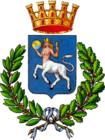 We stayed in a lovely little accommodation in Tourmia. It is called the Condor. The Condor hotel is situated in a quiet and panoramic position in Taormina, a splendid town featuring a mild climate, rich in vegetation and culturally and historically valuable with its Baia di MazzarÒ, Capo Sant'Andrea and Isola Bella. I must warn your that Tourmina is extraordinarily expensive! Buy your trinkets some place else. The hospitality dedicated to Hotel Condor's guests is the result of the experience and passion of the Spartà-Longo family since more 30 years. We were served an excellent continental breakfast on the panoramic terrace of the top floor. The second floor solarium-terrace was equipped with sun beds and shower. A bar-cafeteria, an Internet point, a reception open 24 hours, a comfortable TV room and reading lounge complete the offer of this welcoming hotel. It was pleasant and relaxing. I would also like to add that if your are driving Hotel Condor has a special parking area for your car. Bill and I suggest that you park your car there and leave it for the entire time and walk everywhere. The "roads" as they are called are more like alley ways. An automobile hardly can pass in one direction without turning in the mirrors on both sides! May heaven help you if another can is coming in the opposite direction. Motorcycles do just fine here! Archaeology
The Teatro Greco ("Greek Theater") The present town of Taormina occupies the ancient site, on a lofty hill which forms the last projecting point of the mountain ridge that extends along the coast from Cape Pelorus to this point. The site of the old town is about 300 m above the sea, while a very steep and almost isolated rock, crowned by a Saracen castle, rises about 150 m higher: this is undoubtedly the site of the ancient Arx or citadel, the inaccessible position of which is repeatedly alluded to by ancient writers. Portions of the ancient walls may be traced at intervals all round the brow of the hill, the whole of the summit of which was evidently occupied by the ancient city. Numerous fragments of ancient buildings are scattered over its whole surface, including extensive reservoirs of water, sepulchres, tessellated pavements, etc., and the remains of a spacious edifice, commonly called a Naumachia, but the real destination of which it is difficult to determine. But by far the most remarkable monument remaining at Taormina is the ancient theatre (the teatro greco, or "Greek theater"), which is one of the most celebrated ruins in Sicily, on account both of its remarkable preservation and of the surpassing beauty of its situation. It is built for the most part of brick, and is therefore probably of Roman date, though the plan and arrangement are in accordance with those of Greek, rather than Roman, theatres; whence it is supposed that the present structure was rebuilt upon the foundations of an older theatre of the Greek period. With a diameter of 109 metres (after an expansion in the 2nd century), this theatre is the second largest of its kind in Sicily (after that of Syracuse); it is frequently used for operatic and theatrical performances and for concerts. The greater part of the original seats have disappeared, but the wall which surrounded the whole caveat is preserved, and the proscenium with the back wall of the scena and its appendages, of which only traces remain in most ancient theatres, are here preserved in singular integrity, and contribute much to the picturesque effect, as well as to the interest, of the ruin. From the fragments of architectural decorations still extant we learn that it was of the Corinthian order, and richly ornamented. Some portions of a temple are also visible, converted into the church of San Pancrazio, but the edifice is of small size. Others The Duomo (Cathedral), dating from the 13th centuryPalazzo Corvaja (10th century) Baroque fountain (1635) Church of San Domenico In March 2004, the wife of the Anglican Rector in Taormina related the following story: In 1943 the Allies bombed Taormina on San Pancrazio's Feast Day (July 9) during the celebratory procession. After that, the story goes, Pancrazio was completely discredited as the town's patron. The townsfolk having concluded that his "Patronage" was obviously ineffective. The village of Taormina is perched on a cliff overlooking the Ionian sea. Taormina is approximately a forty-five minute drive away from Europe's largest active volcano, Mt.Etna. In 1927 the young Icelandic writer HalldÒr Laxness (born 1902) published his first major novel, Vefarinn mikli frá Kasmír (The Great Weaver of Kashmir), a panorama of social, literary, religious and sexual issues of his times. Laxness, who won the Nobel prize for literature in 1955, wrote most of his novel in Taormina which he then praised highly in his book of autobiographical essays, Skáldatími (The Time of the Poet) from 1963. Between 1948 and 1999 the English writer Daphne Phelps lived in the Casa Cuseni designed and built by Robert Hawthorn Kitson in 1905, and entertained various friends including Bertrand Russell, Roald Dahl, and Tennessee Williams. 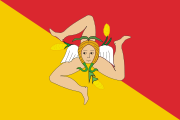 Sicilian Triskelion
"The flag of Sicily, featuring the triskelion symbol revived by Joachim MuratFamiliar as an ancient symbol of Sicily, the triskelion is also featured on Greek coins of Syracuse, such as coins of Agathocles (317-289 BCE). In Sicily, the first inhabitants mentioned in history are the tribes of the Sicani (Greek Sikanoi) and the Sicels (Greek Sikeloi), who have given Sicily its more familiar modern name. The triskelion was revived, as a neoclassic-and non-Bourbon-emblem for the new Napoleonic Kingdom of the Two Sicilies, by Joachim Murat in 1808. The symbol dates back to when Sicily was part of Magna Graecia, the colonial extension of Greece beyond the Aegean. Pliny the Elder attributes the origin of the triskelion of Sicily to the triangular form of the island, the ancient Trinacria, which consists of three large capes equidistant from each other, pointing in their respective directions, the names of which were Pelorus, Pachynus, and LilybŠum. The three legs of the triskelion are also reminiscent of Hephaestus's three-legged tables that ran by themselves, as mentioned in Iliad xviii: 'At the moment Hephaestus was busily
Turning from bellows to bellows, sweating with toil As he laboured to finish a score of three-legged tables To stand around the sides of his firm-founded hall. On each Of the legs he had put a gold wheel, that those magic tables Might cause all to marvel by going with no other help To the gathering of gods and by likewise returning to his house.'" AgrigentoIn Agrigento we stayed in a B&B called Villa Diana. It was lovely and the proprietor was warm and helpful. Our room was clean and visually beautiful. We would highly recommend this accommodation. I would just like to add that we did have our own automobile. I suspect that is an important tidbit as Villa Diana not in a town. It is in a rural area. We did not investigate other transportation because it was not a concern for us. 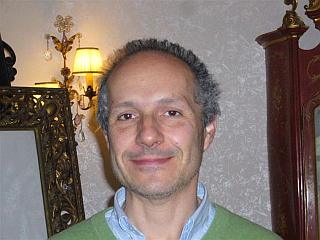 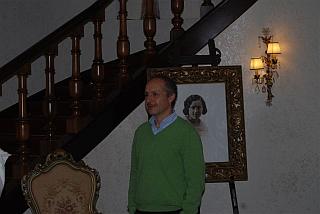 Proprietor, Dario
Agrigento Main Sights
Valle dei Templi Ancient Akragas covers a huge area - much of which is still unexcavated today - but is exemplified by the famous Valle dei Templi ("Valley of the Temples," a misnomer, as it is a ridge, rather than a valley). This comprises a large sacred area on the south side of the ancient city where seven monumental Greek temples in the Doric style were constructed during the 6th and 5th centuries BCE. Now excavated and partially restored, they constitute some of the largest and best-preserved ancient Greek buildings outside of Greece itself. They are listed as a World Heritage Site. The best-preserved of the temples are two very similar buildings traditionally attributed to the goddesses Juno Lacinia and Concordia (though archaeologists believe this attribution to be incorrect). The latter temple is remarkably intact, due to its having been converted into a Christian church in 597 CE. Both were constructed to a peripteral hexastyle design. The area around the Temple of Concordia was later re-used by early Christians as a catacomb, with tombs hewn out of the rocky cliffs and outcrops. The Temple of Concordia The other temples are much more fragmentary, having been toppled by earthquakes long ago and quarried for their stones. The largest by far is the Temple of Olympian Zeus, built to commemorate the Battle of Himera in 480 BCE: it is believed to have been the largest Doric temple ever built. Although it was apparently used, it appears never to have been completed; construction was abandoned after the Carthaginian invasion of 406 BCE. The remains of the temple were extensively quarried in the eighteenth century to build the jetties of Porto Empedocle. Temples dedicated to Hephaestus, Heracles and Asclepius were also constructed in the sacred area, which includes a sanctuary of Demeter and Persephone (formerly known as the Temple of Castor and Pollux); the marks of the fires set by the Carthaginians in 406 BCE can still be seen on the sanctuary's stones. Many other Hellenistic and Roman sites can be found in and around the town. These include a pre-Hellenic cave sanctuary near a Temple of Demeter, over which the Church of San Biagio was built. A late Hellenistic funerary monument erroneously labelled the "Tomb of Theron" is situated just outside the sacred area, and a first-century CE heroon (heroic shrine) adjoins the 13th century Church of San Nicola a short distance to the north. A sizeable area of the Greco-Roman city has also been excavated, and several classical necropoleis and quarries are still extant. Much of present-day Agrigento is modern but it still retains a number of medieval and Baroque buildings. These include the fourteenth century cathedral and the thirteenth century Church of Santa Maria dei Greci ("Our Lady of the Greeks"), again standing on the site of an ancient Greek temple (hence the name). The town also has a notable archaeological museum displaying finds from the ancient city. PalermoWe enjoyed our three days in Palermo. The car we turned in at the airport and then took a bus from the airport to the city. The bus driver will tell you where to get off that is nearest your hotel. It was economical and no scammers to worry about! The fares are set. We found our way to the hotel which was a 5* called the Grand Hotel Wagner. It offered anything that you might need including a willing desk staff who accommodated. It was well located in a lovely part of town. Our room was perfect! Just a note about a special moment in Palermo. Bill and I wandered down to a well known fish market (Mercado Vucciria) and wandered around for awhile. The sights, sounds, smells and activity was a wonder to experience. The following picture is one of a complete sword fish head sitting on a cutting table. We may have had some of that fish for lunch! 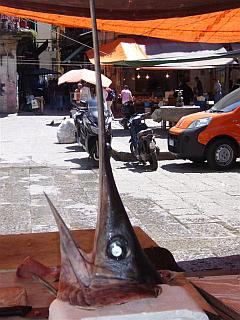 Photo ©HorseHints
We approached lunch time and decided to eat at a restaurant near the fish market. Wandering is the way to go in Sicily. We found some of our best eateries that way. This one was really special. The Sicilian warmth really was there. The pictures below show the restaurant outside area and name. There are also several pictures of one of the staff and myself. They took me into the kitchen and we had some fun. It is a moment to remember. 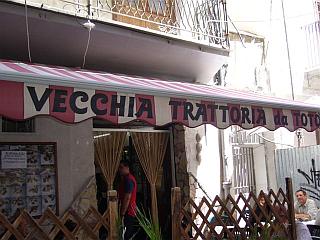 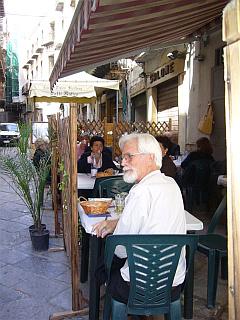  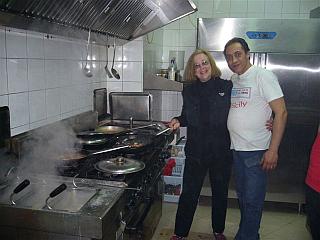 Above Photos ©HorseHints
The Cathedral The Cathedral of Monreale is one of the greatest extant examples of Norman architecture in the world. It was begun in 1174 by William II, and in 1182 the church, dedicated to the Assumption of the Virgin Mary, was, by a bull of Pope Lucius III, elevated to the rank of a metropolitan cathedral. The church is a national monument of Italy and one of the most important attractions of Sicily. The archiepiscopal palace and monastic buildings on the south side were of great size and magnificence, and were surrounded by a massive precinct wall, crowned at intervals by twelve towers. This has been mostly rebuilt, and but little now remains except ruins of some of the towers, a great part of the monks' dormitory and frater, and the splendid cloister, completed about 1200. This last thumb|is well preserved, and is one of the finest Italian cloisters both for size and beauty of detail now extant. It is about 16 m², with pointed arches decorated with diaper work, supported on pairs of columns in white marble, 216 in all, which were alternately plain and decorated by bands of patterns in gold and colors, made of glass tesserae, arranged either spirally or vertically from end to end of each shaft. The marble caps are each richly carved with figures and foliage executed with skill and fertility of invention, no two being alike. At one angle, a square pillared projection contains the marble fountain or monks' lavatory, evidently the work of Muslim sculptors. The church's plan is a mixture of Eastern Orthodox and Roman Catholic arrangement. The nave is like an Italian basilica, while the large triple-apsed choir is like one of the early three-apsed churches, of which so many examples still exist in Syria and other Oriental countries. It is, in fact, like two quite different churches put together endwise. The basilican nave is wide, with narrow aisles. Monolithic columns of grey oriental granite (except one, which is of cipolin marble), evidently the spoils of Antique buildings, on each side support eight pointed arches much stilted. The capitals of these (mainly Corinthian) are also of the classical period. There is no triforium, but a high clerestory with wide two-light windows, with simple tracery like those in the nave-aisles and throughout the church, which give sufficient (if anything too much) light. The other half, Eastern in two senses, is both wider and higher than the nave. It also is divided into a central space with two aisles, each of the divisions ending at the east with an apse. The roofs throughout are of open woodwork very low in pitch, constructionally plain, but richly decorated with color, now mostly restored. At the west end of the nave are two projecting towers, with a narthex (entrance) between them. A large open atrium, which once existed at the west, is now completely destroyed, having been replaced by a Renaissance portico by Giovanni Domenico and Fazio Gagini (1547-1569). It is, however, the large extent (6,500 m²) and glittering splendour of the glass mosaics covering the interior which make this church so splendid. With the exception of a high dado, itself very beautiful, made of marble slabs with bands of mosaic between them, the whole interior surface of the walls, including soffits and jambs of all the arches, is covered with minute mosaic-pictures in brilliant colors on a gold ground. The mosaic pictures are arranged in tiers, divided by horizontal and vertical bands. In parts of the choir there are five of these tiers of subjects or single figures one above another. The half dome of the central apse has a colossal half-length figure of Christ, with a seated Virgin and Child below; the other apses have full-length colossal figures of St. Peter and St. Paul. Inscriptions on each picture explain the subject or saint represented; these are in Latin, except some few which are in Greek. The subjects in the nave begin with scenes from the Book of Genesis, illustrating the Old Testament types of Christ and His scheme of redemption, with figures of those who prophesied and prepared for His coming. Towards the east are subjects from the New Testament, chiefly representing Christ's miracles and suffering, with apostles, evangelists and other saints. The design, execution and choice of subjects all appear to be of Byzantine origin, the subjects being selected from the Menologium drawn up by the emperor Basil II in the 10th century. Although not so refined as mosaics in Cefalù and the Palazzo dei Normanni, the cathedral interior nevertheless contains the largest cycle of Byzantine mosaics extant in Ita In the central apse at Monreale, behind the high altar, is a fine marble throne for the archbishop. This position of the throne is a survival of the early basilican arrangement, when the apse and altar were at the west end. In that case the celebrant stood behind the altar at mass, and looked over it eastwards towards the people. On the north side, in front of the high altar, is another somewhat similar throne for the use of the king. The tomb of William I of Sicily (the founder's father), a magnificent porphyry sarcophagus contemporary with the church, under a marble pillared canopy, and the founder William II's tomb, erected in 1575, were both shattered by a fire, which in 1811 broke out in the choir, injuring some of the mosaics, and destroying all the fine walnut choir-fittings, the organs, and most of the choir roof. The tombs were rebuilt, and the whole of the injured part of the church restored, mostly very clumsily, a few years after the fire. On the north of the choir are the tombs of Margaret of Navarre, wife of William I, and her two sons Roger and Henry, together with an urn containing the viscera of Saint Louis of France, who died in 1270. The pavement of the triple choir, though much restored, is a very magnificent specimen of marble and porphyry mosaic in opus alexandrinum, with signs of Arab influence in its main lines. The mosaic pavement of the nave was completed in the 16th century, and has disks of porphyry and granite with marble bands intermingled with irregular lines. Two baroque chapels were added in the 17th and 18th centuries, which are fortunately shut off from the rest of the church. The bronze doors of the mosaic-decorated portal on the left side was executed by Barisano da Trani in 1179. This is a must. Although it is bizarre to see, it is, in fact, quite interesting. Check the times before going as the Catacombs closes for several hours around lunchtime.
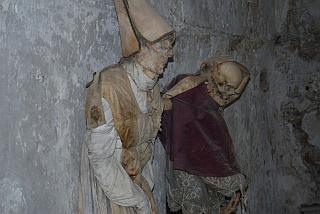 Photo ©HorseHints
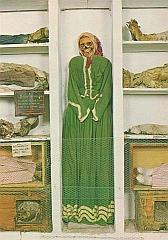  I would like to say, also, that Bill and I stopped between our major city destinations to see sights along the way. I cannot mention all of these, but we used the Frommers and other research which we did before our trip. Having the freedom of an automobile allowed us to take side trips and explore paths that are often not seen by tourists. Much of the fun of travelling without a pre-planned travel group is that you can experience a country on a more intimate way. There is no guide to weave you through the maze. It is up to you. There is no get up at 6:00 AM and be on the bus by 8:30 AM. Do not be late or we will leave without you. We very much enjoyed our leisurely Sicilian experience. No one bothered us or tried to scam us. People were friendly and helpful. So many destinations are changing rapidly with the ease of global travel. I can only hope that when you take your Sicilian adventure it will be as enjoyable as ours. For more information on your Sicilian Trip: Frommer's Italy 2005RomeI would like to say that this was a return trip to Rome for Bill and me. A number of years ago we toured all over Italy from Spoleto to Melan. That was an incredible trip. We returned home with a memory of the wondrous sights and warmth of the people. At that time we were fortunate enough to have seen most of the tourist sights in Rome. This trip we wandered around the streets from a different perspective. We did, however, take the bus to the Vatican on Sunday. Every Sunday at noon the Pope appears at the second window from the right on the right side of the square facing Saint Peter's Church. A burgundy and gold textile is placed on the balcony so that you know where to look. The Pope then addresses the people in the square in many languages. If you do not get there early there is standing room only. What we saw this trip really saddened us. Rome was over-run with hoards of people. The sights had lines that made Disneyland and Disneyworld look like a two second wait. For example, there was not one inch of unoccupied space on the Spanish Steps. The lines for the Colosseum were endless. Graffitti was everywhere in Rome including on the National Treasures. It was shameful in my opinion. Also there were scammers, pickpockets, gypsies, and cheating cab drivers everywhere. People were not warm nor were they friendly unless they were trying to scam you. I plan to do another article and specifically warn about the many scams that we encountered. However, I would like to warn now--if someone asks you directions from a car it is probably a scam. They just want to make contact and strike up a conversation so that they can run a scam. We had this happen twice in one day! Also, make sure you know the cost of the cab ride. If you do not, before you pay go into the hotel and ask at the desk the approximate cost of the fare. If the cabbies ask you for your train or bus tickets they are probably about to run a scam. If the cabbie makes a big deal out of turning on a meter it is probably a scam! Even the churches were asking people to leave and closing their doors. I could not believe it. Hotel HiberiaWe got lucky with the hotel. It turned out to be perfectly located and our view from the room was unbelievable. We looked out over the Alter of the Nation, in all its grace. It is rated a 3* hotel, but was more than adequate. Breakfast was included in the price of the room. Dino, at the desk, was terrific. Although the hotel had 42 rooms it gave the flavor of a "boutique hotel." The room was lovely and the staff at the desk very helpful. Dino told us about a wonderful Gelato shop on the far side of town. We took a bus and lined outside the shop. People were waiting in line to enjoy the delights. We had an ice cream that was sumptuous, "tiramatsu."  Dino at the desk/Hotel Hiberia
 The best ice cream ever! |